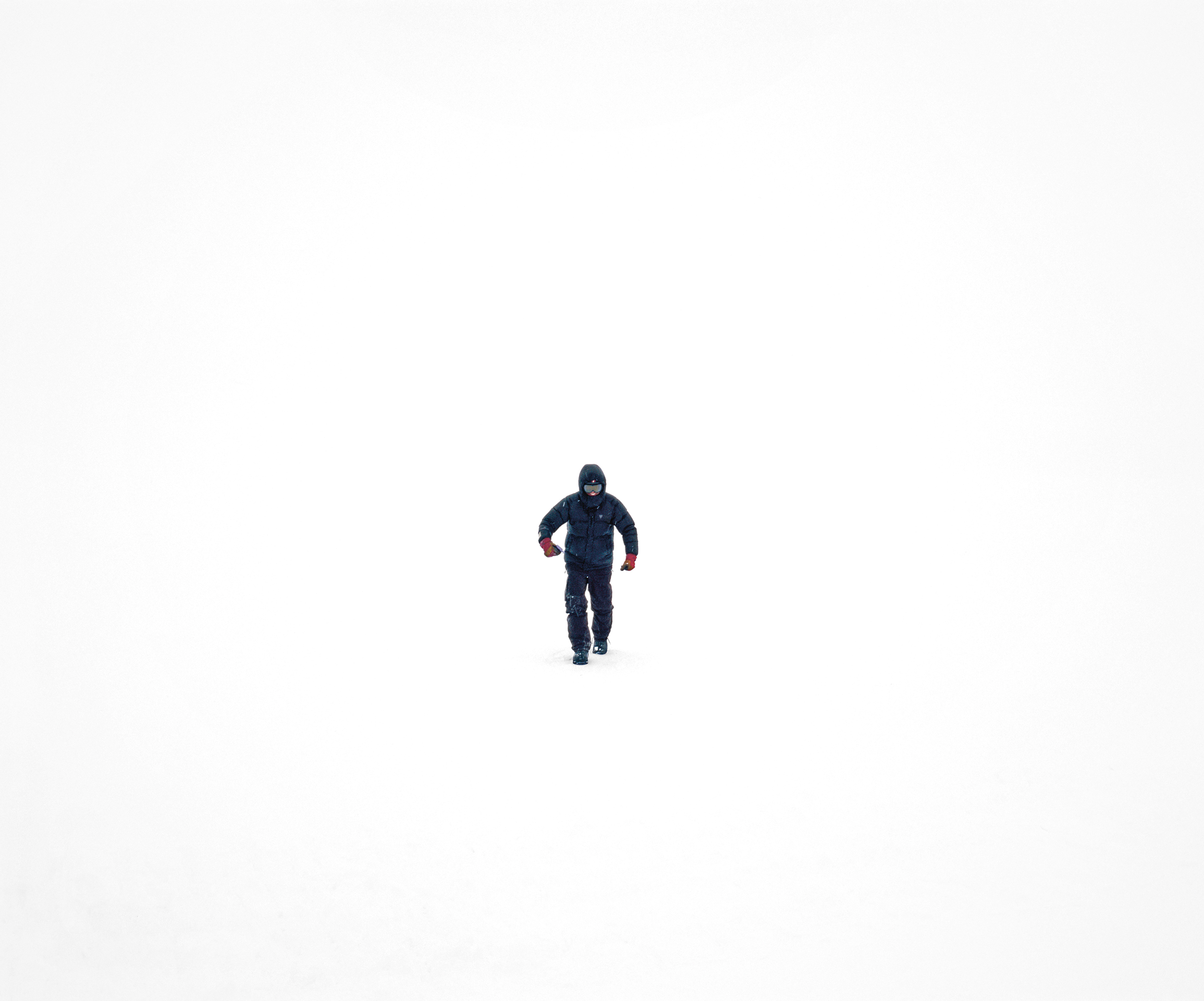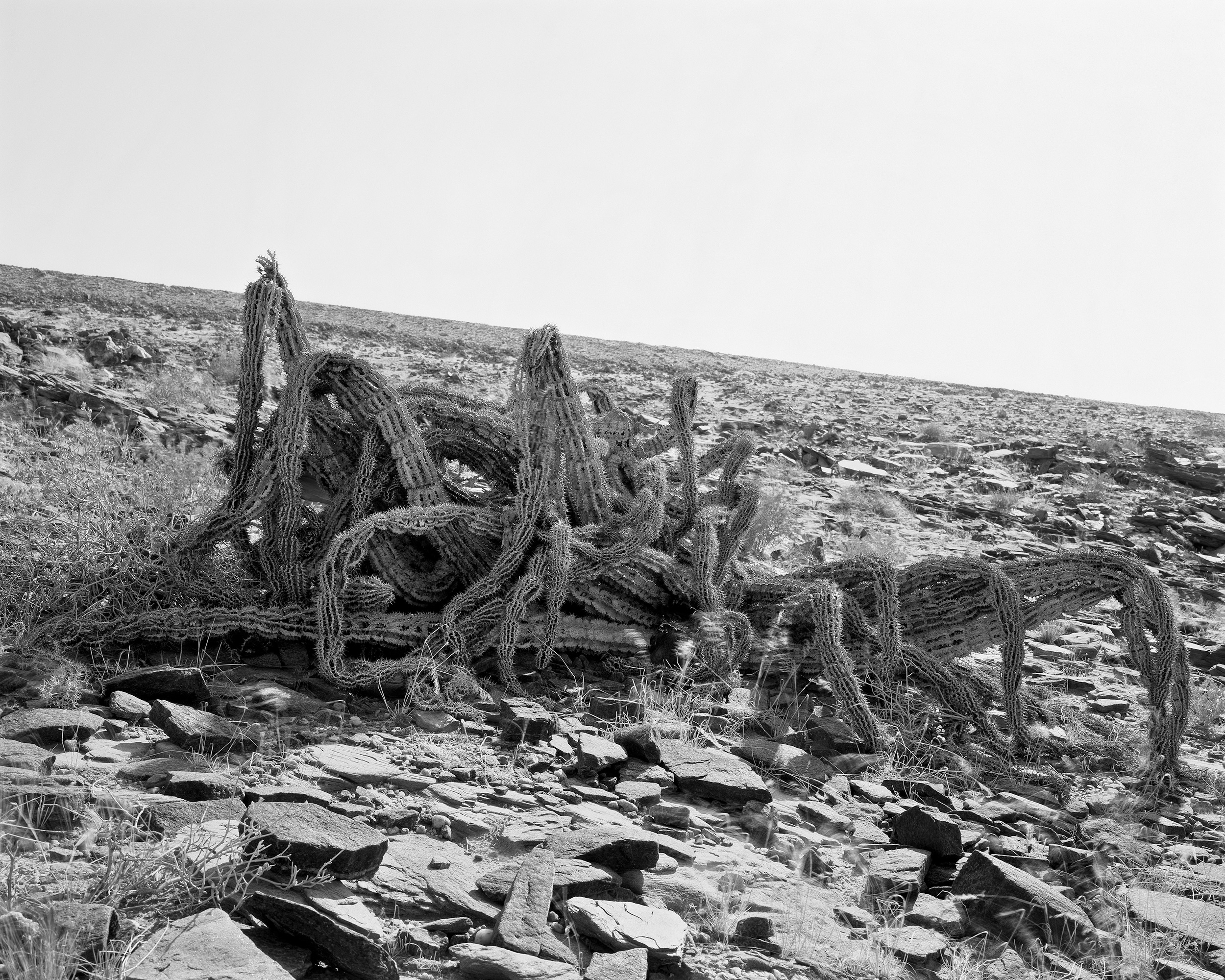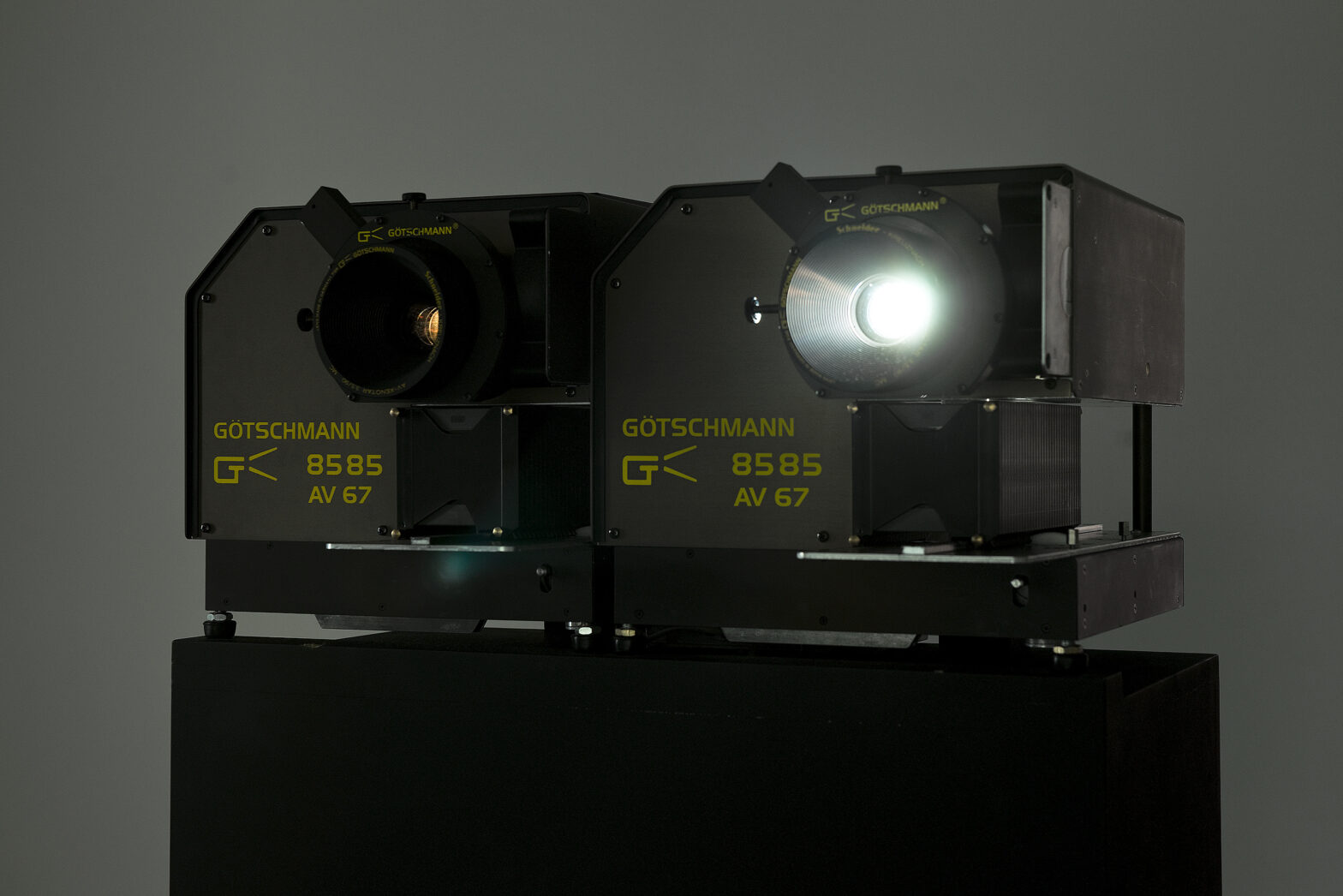In Ausstellungen zeigt der belgische Fotograf Geert Goiris seine Arbeiten häufig als Diaprojektion. Für seine Serie Whiteout reiste er in die Antarktis, um das gleichnamige meteorologische Phänomen, das in den Polargebieten und in Hochgebirgen auftritt, zu fotografieren und zu untersuchen. Hierbei kommt es zu der optischen Besonderheit, dass Konturen und Horizont aufgrund diffuser Reflexionen verschwinden und Materie durch die Einwirkung des Lichtes scheinbar verschwindet.
Marcus Heine und Annelot Meines besuchten Geert Goiris in seinem Studio in Antwerpen, um über das Medium Diaprojektion, Editing, die Sequenzierung seiner Fotografien und die Verwendung des Archivs zu sprechen.




#00:07:47-5#
Goiris: Of course the slide show is a very convenient medium in that, you know, if you want to produce thirty large prints you need a truck, a lot of money and all that is logistically, well, it‘s just a nightmare. With slides it‘s easy. I can put two projectors in my car and travel anywhere. But aside from these practical considerations, I really started employing projectors for a specific reason when I was working on Whiteout. I went to Antarctica with the idea and the desire to photograph this phenomenon. It is a relatively rare optical and meteorological condition occurring when there is a high concentration of ice crystals in the atmosphere. These particles diffuse the light which results in a uniform white light hitting the snow and ice on the ground. The light is endlessly reflected from these white surfaces, trapped in a sort of ‘echo chamber‘. What happens visually during a whiteout is that at first the horizon is disappearing and then, all of a sudden, you‘re enclosed by a cocoon of bright white light. It is like a transformation of matter into light. Everything around you disappears and turns into light. The experience is different than finding yourself in a thick mist or fog. If the three of us would be in a whiteout we would still be able to see each other clearly, but without a visible horizon or any surface on the ground. We would seem to float in a white void. Antarctica is an extreme continent with specific conditions. The inside and the outside are separated by a salient threshold: you always have to prepare for the harsh conditions outside. Another important element is the light: it‘s always bright. There is so much light that you need to wear glacier sunglasses and you feel the sun burning your skin, even though it is cold outside. When I was there, the sun was shining 24 hours a day, so the experience was very different from what I‘m used to in northern Europe. Being present in such an unreal place and witnessing matter disappearing, or at least having the perception that matter was transforming into light, made it very clear to me that I needed to present the series as a light projection.
There is also an element of disbelief and narration poking the viewer into one direction. When, you know, I traveled to the other side of the globe to make these photographs, it makes them slightly heroic, but when you look at these images closely, they basically resemble a blank page. There is almost nothing there.
The process seems futile but magical: I travel there, expose a piece of film, bring it back, put it in the slide projector, let light shine through it and something is being recreated. The original – the slide – is a true original that has been there as well. There were different reasons for choosing slide projection as the adequate medium for that piece. After Whiteout I started working more with these projectors. Now I‘m more interested in the editorial quality of this medium. As a narrator I can say ‘’ok, this is the slide piece, it‘s 6 minutes long, it starts with this image for ten seconds, then it fades into the next image‘‘. It becomes a time-based piece, an experience. What I love about it, is the undefined status of such a projection: situated somewhere between photography and film, static yet moving, it has the quality of cinema, but in a very primitive way.
#00:16:24-0#
The mechanics of these projectors sets them apart from digital beamers. It‘s never completely perfect. Even though there is a quite amazing degree of control – I can time the projectors to a fraction of a second and it will reproduce that command, but with fluctuations. As the slide needs to be transported mechanically and has to fall into the right space, there is always room for error. The timing is never completely exact. For me this is fine, it lends a slightly unexpected air to the otherwise sophisticated projection of 6×7 slides. And the technical quality of the image is surpassing most of the top-range digital projectors.
#00:18:40-4#
There is something honest about a slide – well, of course one could make a photograph, manipulate it digitally and then flash it back onto slide film, but that is not something I would do – it needs to be exposed and framed well. Once it is photographed, there is no chance for post-production or reframing.
A projection might seduce through its scale and luminosity, but at the same time it is also quite humble: it doesn‘t have the same weight as framed prints. It is not the same as walking into a big space where there are 10 huge framed prints saying: ‘’Money, power, this is an established artist, this work has prestige‘‘. A slide projection feels ‚lighter‘. It is true that analogue projection has become a fetishized way of showing in contemporary art, but I am under the impression that the hype is slightly over. All of a sudden so many artists wanted to work with slides for nostalgic, economic and other reasons. It is intriguing to recreate an image through light: at the same time a technological, poetical and philosophical act.
#00:22:10-0#
You can put a plinth in a room with two projectors connected to a dissolve controller. When all the cables are hidden it‘s like an autonomously functioning machine, an image producing device. Such a set-up is fantastic and becomes more and more important to me as a photographer. Why are we using photography? Why did we feel a need to create this technology? The slide projection is very much an embodiment of these questions.
When I exhibit works I never show my camera, of course not, it‘s kind of a taboo, it‘s considered to be bad taste. But the camera and the whole apparatus used to get to the image is extremely important. With the slide projection the apparatus is all there, without concealment. I hope that people will walk into the exhibition, look at the images and then after a while notice the technical construction, like: ‘’Oh, what‘s this? What kind of machine is this?‘‘
#00:24:412-4#
In a slide show you can trace the editorial decisions clearly: the sequencing, time and duration – it‘s all there. In a book, you can understand which image the author wanted you to start with and the sequence he or she was proposing. Often when I pick up a book, I start from the back, because it feels more ergonomically. I go through it and then realize, that the author wanted me to look at it differently, starting at the beginning. The sequence is clear, but there is freedom to browse at will. With a slide projection this is not possible. A viewer can enter in the middle of the projection. But when it is looped, there is the possibility to pick up the thread of the narrative.
#00:28:20-0#
The projection of Whiteout is running in a loop. A viewer can walk into a segment with many white images or when the photograph of the ship is there. This changes the narration quite significantly: If I see the ship first it starts like an adventure story, but when it opens with the almost white images I wouldn‘t even know what I‘m looking at. There are also some photographs of interiors, these are darker and colorful. When a white and very bright slide comes up afterwards, there is a strong sensation happening with your eyes, because suddenly they have to adapt to much more light. This projected effect comes close to the experience of being there.
#00:35:52-1#
I like to stage the technology transparent, almost naked. Think of the cuts between images and the sound of the machinery. Even if I use a dissolve, the editing feels so simple and awkward, all the
cuts are mechanical and accentuated by the sound of the projectors. Every time we watch a film or television we see so many cuts done so well that they nearly escape our consciousness. There is so much finesse in editing and then I come up with these simple machines putting one image after another. The only thing they can do is a rough cut or a dissolve, that‘s it. But still, only by giving one image three seconds and then let it dissolve for two seconds, even with the most simple binary possibilities, it is still possible to express something.
#00:44:05-7#
Walker Evans talked about documentary style as a modus operandi, a position of responsibility to what is out there. I can identify with this. I seldom stage things to be photographed. More often I use a camera to note sights that I find. So I would argue that it is documentary, but without stating that a place ‘is‘ like this or that. The images are not representations of places, plants or people. It‘s more a recollection of a particular way of seeing that connects to visual narration, cinema and television. I watched quite a lot of TV when I grew up and many of its visual codes were imprinted on me. Our access to the world is always filtered. That is something that I work with. When I come across this particular plant in the desert, I can‘t help it. I just need to photograph it because it‘s photogenic, but why is it photogenic? It has two faces: one is a real plant, but it also looks like a spider. Something in the scale and ‘posture‘ calls to mind a depiction of an alien. How is this concept of alien visualized? Where does it come from? Science fiction movies?
Photography can cite and refer to the visual culture that we share without any problem. It goes smoothly though in fact it‘s quite complex. So when I discover something worth photographing, I try to record as much detail as possible. Being precise makes it even more ambivalent. When you stand in front of a large print you can see all that is there, I don‘t try to hide something. The approach is straightforward and yet still something is out of balance. It is not so much about a specific photographic style or authorship, but more about engaging codes of visual communication and presenting these in theatrical ways.
#00:54:09-9#
The images need to be autonomous. One way of setting them free is gathering images from different times and places and positioning them in a way that enables communication among one another. A lot of images don’t derive from conscious decisions. I don‘t get out of bed in the morning thinking ’’I‘m going to make this particular photograph‘‘. It‘s more like fishing, you know, you go out in the ocean, throw your line and wait to see what comes up.
Collecting images like this for many years, I start to see patterns. Over time it becomes clearer what I consider to be photogenic, what I recognize as meaningful or interesting and when things start to match. I like to mix different locations and times so an imaginary world unfolds. Narrative conventions hold it together so we can still enter. It is not completely abstract, but has an inner logic and a photorealistic quality. Clearly these are real places, but there is a level of … not confusion, but vagueness, added by combining these images. I guess it‘s the same with every photographer: when you put images together it somehow recreates a certain way of looking.
#01:02:00-3#
Editing is fundamental to photography. Framing lends subjectivity to a photograph: what you choose to include and what not. The editing process is another step where a series can acquire personality. That‘s why an archive is important. Somehow it‘s crucial to have different options and images ready to combine.
#01:04:07-0#
There are those moments when I don‘t have inspiration. Then I go through my archive and playfully put images together, or I find some traces of research I‘ve started once before. Then after a while the feeling or energy to make something comes to me. An archive is materialized memory where one can trace certain interests or intentions. Sometimes I ask myself, ‘’Why did I take this?’’ But it happens that there is something in the image itself, interesting in its own right, stripped away from the intentions I might have had.
#01:43:05-5#
Going through my archive is like browsing through a library: while looking for a specific book I can also see what is next to it.
It is not like going to a library and asking for this book and it’s brought to me, that‘s not the same. Obviously our world is becoming more like that, Google search uses artificial intelligence getting cues from your preferences. If you regularly look for a specific kind of architecture it will store the filter settings and will give you more examples of the style of architecture you have previously looked at. So our view on the world is expanding and narrowing down at the same time. We have access to more than we can ever digest, but it‘s a self-reflecting universe. What I appreciate in a physical archive is that sometimes there are surprises because I don‘t throw things away. Nearly 85 percent of my archive is boring, but maybe one day some insignificant photograph will emerge as a valid image, because I would be looking at it with a different frame of mind.
Time is co-authoring the archive. Something that is not relevant or looks completely boring today, might become important in twenty years because it depicts a person, place or atmosphere that is dear to you. The reading changes over time.
#01:45:02-4#
Slide projections and books are both time-based media. But a book is more free: the viewer/reader chooses how much time he or she wants to spend on each page and can go back and forth. In a projection the sequence is constructed in a particular way, there is no way of escaping it, you can only decide to leave.
We have a long tradition of reading books, so it feels extremely familiar. A projection in a museum is also a scripted event: the moment you enter, a kind of contract between viewer, author and context comes into effect. The viewer enters a space where attention is required. Looking at a slide projection in an art context or inspecting a painting in a gallery makes us adopt this analytical position. There is also a different proximity. A book feels intimate and close. A projection is more a shared experience and has a different aura through the light and spectacle. In a book we look at reproductions, the image size defined by the format of the book. I believe you can get some of the aura back by the choice of paper and the tactile qualities of a book, but looking at a book is clearly different than seeing prints or projected images. What I really love about the book and why, in fact, I would prefer it over the exhibition, is that it is a mass medium with a low threshold. It is democratic and travels easily. You can send it, give it to people, eventually books find their way.
#02:04:45-1#
Combining images from my archive is a way of releasing them from the real and factual. I always feel a need for nuance. If I have an image of a ‘UFO‘ I want to balance it with something else, because I do not want to be the photographer working with science fiction. If I have too many empty landscapes, I need to counter it with something else. As soon as you think ’’OK, his work is about that…‘‘ I want to insert another element pointing at a different direction, disturbing the expectations.
Das Gespräch fand am 18. Juli 2016 in Antwerpen statt.
